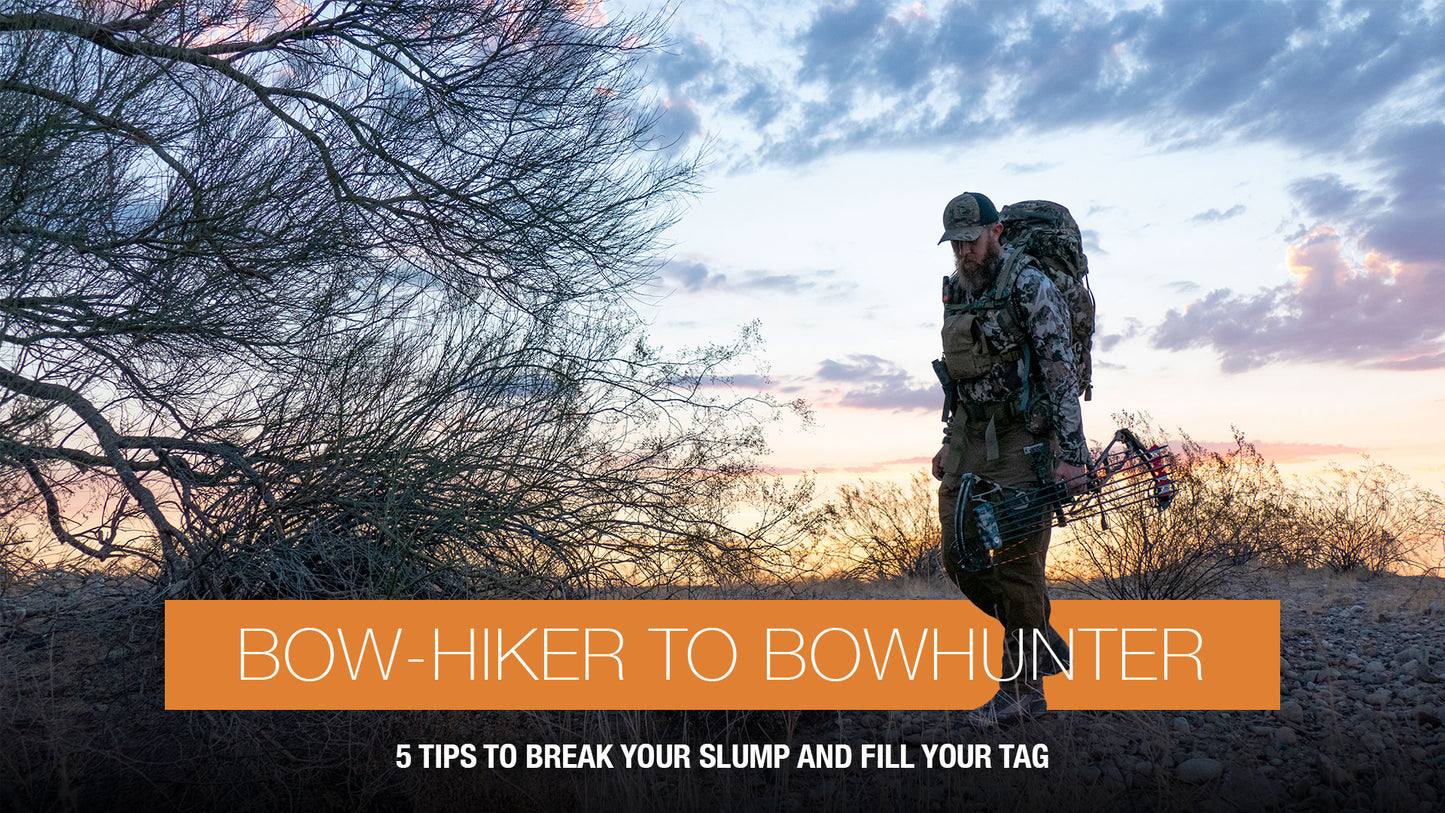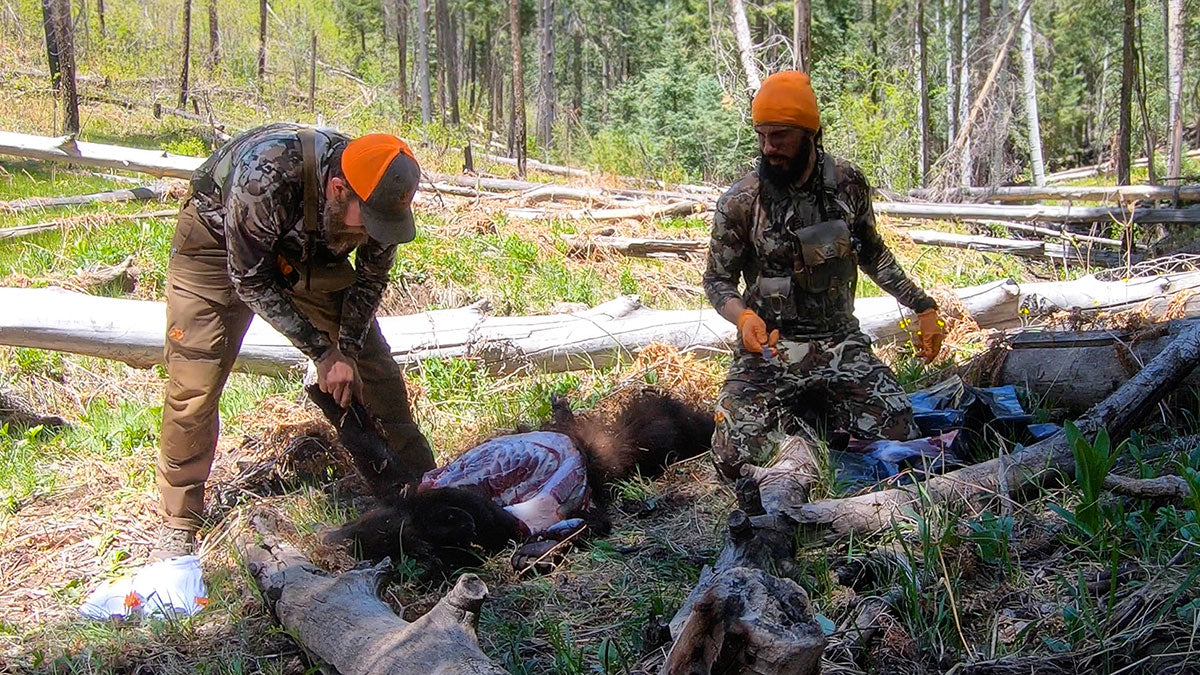
We’ve all been there at some point in our hunting journey. Maybe it was a few long weekends in a row or a years-long slump you endured. Or maybe you’re at the beginning of your bowhunting life and it feels like the learning curve is just insanely steep. Whatever the circumstances, it’s possible you identify (half-jokingly...half-depressed) as a bow-hiker. You know, the person who feels like all they’re really doing day after day is taking their bow for nature walks.
I’ve absolutely been there before (and the way hunting goes, will probably be there again at some point), so I feel your pain. But, having battled through the bow-hiking days, I can think of at least five things that are absolute game changers when you feel like you’re just grinding and the hunt isn’t cooperating.
STAY ALERT
This may sound obvious, but after days of bow-hiking, it gets really easy to get discouraged, to then become distracted, and that’s when you miss an opportunity simply because you weren’t ready. I remember my second elk hunt ever in AZ, and it was the fourth or fifth day of 7-10 mile bow hikes that week. I had been into elk, had been at full draw a couple times, and had even missed a shot that deflected off a sapling...but it had been a couple days since there was any real action. I found myself just hiking from one point to another, totally immersed in a daydream, and at the deepest point of “this will never happen” in my mind. That’s when I walked past this little finger of pine trees and found myself standing 15 yards from a spike that was just feeding in the open and had been right on the other side of those trees the whole time. He stood there trying to figure out what I was for a surprisingly long time, but not nearly long enough for me to get my bow ready, nock an arrow, and all the other steps that stood between me and that harvest.
The truly frustrating part is that based on where he was, had I simply been paying attention, I would have seen him long before we had our little standoff in the meadow and would have probably been able to make a play on him. This is 100% the mental side of bowhunting, but one of the best things you can do to break out of the bow-hiking world is to continually stay alert - believing that everything could change at any moment. The number of times I’ve seen a hunt go from absolutely nothing to an arrow loosed in a matter of seconds is astronomical. So, keep your head in the game and truly believe to your core that at any given moment everything could come together.

SEEK OPPORTUNITIES OVER TROPHIES
I would never presume to tell another hunter what he should or shouldn’t pursue. If you’re all-in on harvesting a certain size of animal, more power to you. But, if you’re on the newer side or you feel like your bow-hiking stretch is growing pretty long, allow me to encourage you to re-think your goals (at least for now). When it comes to becoming a consistently successful bowhunter, there is nothing that can replace the value of “at-bats.” The more opportunities you have to spot animals, stalk in on them, and try to seal the deal, the better you’ll get.
Perhaps you’ve been hunting a unit or an area where the trophy potential is pretty high, but the animal densities are low. Personally, I’d begin building my hunting plans around animal populations and success rates - the higher the better. It can be hard if you’ve grown familiar with a certain hunting spot and you’ve seen just enough animals to know that there are some critters running around, but it’s very possible that with a little research and a willingness to explore the unknown, you could find a bowhunter’s paradise in the next unit that will give you exponentially more opportunities to put that bow you’ve been hiking around with to good use.
KEEP YOUR MORALE UP
As hunters, we tend to pay a lot of attention to the physical side of a hunt and the ability to stay out there and keep grinding. Especially for the bow-hiker, the mental grind of a hunt can be twice as difficult as any physical challenge you might face in the backcountry. If you’re just not seeing animals or you’ve blown a couple stalks already because of some simple mistakes, the ability to stay positive (or even stay out there altogether) begins to wane. That’s why I think it’s imperative that you find ways to boost your mood and keep your morale up, even when everything seems to be going wrong.
What works for each hunter will be a bit different, so you may have to experiment with a few ideas and see what helps pull your mood out of the pit. For me, there are few things a couple handfuls of Sourpatch Kids can’t fix. I always have them in my food bags for some quick energy before making a big climb, but more often than not I start cracking into them by mid-afternoon of an all-day glassing session. When I’m hot, tired, and just not seeing what I’m looking for, I definitely start to get a little down. Once I break out the sugar, I instantly feel better and hopeful that the next scan of that ridge is going to turn up the animal I’ve been searching for all day. For you, it may be a quick power nap, maybe a call or text home just to check in and get recharged, or a cup of coffee at your glassing point. If it’s a particularly long hunt, maybe even giving yourself permission to sleep in one day will do wonders for your mental state. Whatever it is, know what can boost your morale and use those strategies as often as necessary so you can stay out there and keep hunting.

KEEP FIELD NOTES
This is an old-school idea inspired by the likes of Teddy Roosevelt and Fred Bear, but I’m learning there’s something extremely helpful about keeping field notes while you’re out there. Obviously, this can be just a note in your phone, but I think the tactile feel of a small notebook is way cooler for this task. When you get back to camp for the day - or even when you return to your glassing point from an unsuccessful stalk - break out the notebook and jot down what happened. Where was the animal? How did you approach? What was the wind doing? What went wrong? Not only does this give you a great trip down memory lane if you keep these kinds of notes for years, but it’s an incredible learning tool to make you a better bowhunter.
Yes, there’s instinct involved in bowhunting and some guys just seem to have this inexplicable knack for sneaking into range and getting it done. But, the vast majority of us are just learning one lesson after another until we start to figure out how this whole thing works. Keeping and reviewing your own field notes will help you really absorb the lessons you’re learning out there so you don’t keep making the same mistakes or just bouncing around the hills aimlessly. The exercise forces you to really evaluate how you’re hunting and mine for nuggets of information you might not even notice had you not taken the time to write it down.
FIND A MENTOR OR TEAMMATE
I’m a huge fan of solo hunting, so I’m certainly not discouraging that pursuit if you’re into it. But, so much can be gained from finding a mentor and/or a hunting teammate when you’re struggling to break the bow-hiking cycle. If you can get into the field with a more experienced bowhunter, it can be like a master’s class in what you’ve been missing. Ask a bunch of questions. Watch them go on a stalk. Have them watch you stalk an animal, and ask them what they saw go wrong if it doesn’t work out. Plus, there are obviously advantages to having someone back at the glassing point who can give you signals and help guide you into the bedded buck you’re stalking.

If you don’t have this person in your life, it can seem extremely daunting to just go out and find one. Plus, there’s a certain level of social weirdness in just asking a perfect stranger if you can go hunting with them. I’d say start small and just try to pick someone’s brain, whether that’s in person or even over social media. In fact, one of my best hunting buddies started this way. I was trying to learn how to hunt bears in Arizona (which is an incredibly difficult hunt) and found this guy on the internet who was “the bear guy” in our state. I reached out and offered to buy him coffee if he’d let me pick his brain for an hour or so. Well, several years later we’re good friends, we hunt together numerous times a year, and he played a massive role in getting me my first bear harvest. I’m extremely grateful that’s how this relationship progressed, but even if it had been nothing more than that first coffee, I would have still walked away with a ton of information that would have helped me figure out Arizona bear hunting. So, if you’re struggling as a bow-hiker, reach out to a few people who seem to be further down the road...most hunters would be happy to at the very least share information, and in some cases may even be willing to share a camp with you.
HANG IN THERE
Believe me, I know how discouraging it can feel to be a perennial bow-hiker. I’ve been there myself, and I talk to plenty of people struggling through the same thing. Accept that there’s a process to this whole bowhunting thing, and take every lesson learned and small victory as a sign that you’re making progress. I firmly believe that if you apply these five game changers to your strategy, you’ll see things turn around fairly quickly and you’ll finally feel like you’ve moved from bow-hiker to bowhunter.
Eric Voris is a passionate adult-onset hunter, the author of How to Hunt: A Total Beginner's Guide to Hunting Big Game, and the creator behind Late to the Game Outdoors. He is an accomplished writer, filmmaker, and content creator in the outdoors space, and spends his time chasing animals across the West. Eric lives in Arizona with his wife and three kids, dodging rattlesnakes and hunting together whenever possible.
